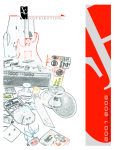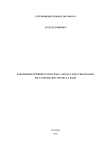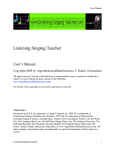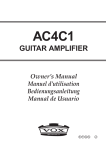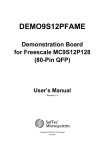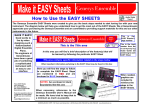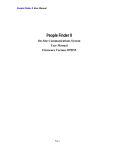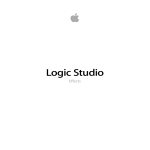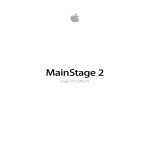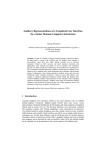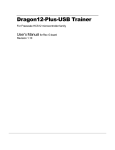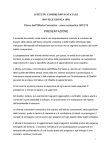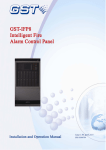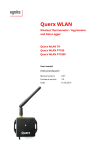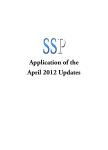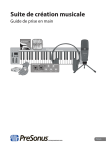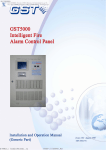Download USER MANUAL
Transcript
The ultimate sound and groove workstation USER MANUAL SampleTank 3 Table of Contents Contents 2 English Chapter 1 – SampleTank 3 Overview 1.1 Introduction 1.2 Features Chapter 2 – Getting started with SampleTank 3 2.1 - Using SampleTank 3 as a standalone application 2.1.1 - AUDIO/MIDI Settings 2.1.2 - PREFERENCES Settings 2.1.3 - REMOTE Settings 2.2 - Computer keyboard keys 2.3 - CPU Monitor 2.4 - Using SampleTank 3 as a plug-in 2.4.1 - Syncing to the host application’s tempo 2.5 - Custom Shop Chapter 3 – The PLAY page 3.1 - Overview 3.1.1 - Three Types of Instruments 3.1.2 - Loop Instruments and Global Play 3.1.3 - Syncing Loops 3.1.4 - Master BPM and Key 3.2 - The MULTI tab 3.2.1 - Multi Menu 3.2.2 - Search Multis 3.2.3 - Rescan Multis 3.3 - The INSTRUMENTS tab 3.3.1 - Instruments Menu 3.3.2 - The INFO button 3.3.3 - Search Instruments 3.3.4 - Favorites 3.3.5 - Rescan Instruments 3.3.6 - Browsing Instruments using keyboard arrow keys 3.4 - The PATTERNS tab 3.4.1 - Loading Patterns 3.4.2 - Activating Patterns 3.4.3 - Removing Patterns 3.4.4 - GLOBAL Play Button 3.4.5 - Pattern INTENSITY Slider 3.4.6 - Pattern KEY 3.4.7 - Pattern QUANTIZE 3.4.8 - Loop instruments in the Pattern viewer 3.4.9 - Pattern Audition Play Button 3.4.10 - Octave Shift Buttons 7 2 7 7 11 12 12 13 14 15 16 16 17 17 18 26 26 27 28 29 29 30 31 31 31 32 32 34 35 35 35 35 36 36 37 37 38 38 38 38 39 39 40 Contents SampleTank 3 3.4.11 - Search Patterns 3.4.12 - Rescan Patterns 3.5 - The LIVE tab 3.5.1 - Set Lists 3.5.2 - The Song Column 3.5.3 - The Multi Column 3.5.4 - Memory Management in LIVE mode 3.6 - Quick Access Panel Chapter 4 – The MIX page 4.1 - Overview 4.1.1 - INSTRUMENT and MULTI Menus 4.1.2 - Instrument Icon Display 4.2 - The MIX Channel Strips 4.2.1 - Insert Effects 4.2.2 - Effects Lock 4.2.3 - Save / Load Effects 4.2.4 - Effect Sends 4.2.5 - Pan Slider 4.2.6 - Mute and Solo Buttons 4.2.7 - Volume Slider 4.2.8 - Master Channel Chapter 5 – The EDIT page 5.1 - Overview 5.1.1 - INSTRUMENT and MULTI Menus 5.2 - The PART Strip 5.2.1 - MIDI Channel drop-down menu 5.2.2 - Polyphony 5.2.3 - Transpose 5.2.4 - Note Range 5.2.5 - Velocity Range 5.2.6 - Pan 5.2.7 - Volume 5.2.8 - Mute and Solo buttons 5.2.9 - Zone button 5.3 - The SAMPLE Strip 5.3.1 - Pitch 5.3.2 - Fine 5.3.3 - Bend 5.3.4 - Sample Pan 5.3.5 - Synthesis Types 5.3.6 - Round Robin Freeze 5.3.7 - Element Selector 5.4 - The FILTER Strip 5.4.1 - Filter Type Menu 5.4.2 - Filter Frequency 3 40 40 41 42 42 42 42 43 44 44 45 45 46 47 47 47 48 49 49 49 50 51 51 52 52 52 52 53 53 53 53 53 53 53 54 54 54 54 54 54 55 55 56 56 56 Contents SampleTank 3 5.4.3 - Resonance 5.4.4 - Overdrive 5.5 - The VELOCITY Strip 5.5.1 - Velocity to Amp knob 5.5.2 - Velocity to Pitch knob 5.5.3 - Velocity to Resonance knob 5.5.4 - Velocity to Filter knob 5.5.5 - Velocity to LFO1 Depth knob 5.5.6 - Velocity to Env2 Sustain 5.6 - The LFO Strip 5.6.1 - LFO Selector 5.6.2 - LFO Sync 5.6.3 - LFO Free 5.6.4 - LFO Rate 5.6.5 - LFO Depth 5.6.6 - LFO Phase 5.6.7 - LFO Fade 5.6.8 - LFO Waveform 5.6.9 - LFO to Pitch knob 5.6.10 - LFO to Filter knob 5.6.11 - LFO to Level knob 5.6.12 - LFO to Pan knob 5.7 - The ENVELOPE Strip 5.7.1 - Envelope 1 to Level knob 5.7.2 - Envelope 2 to Filter knob 5.7.3 - Envelope 2 to Pitch knob 5.8 - The KEY Strip 5.8.1 - Keyboard Mode menu 5.8.2 - Portamento 5.8.3 - Curve Chapter 6 – MIDI control 6.1 - The LEARN button 6.2 - The CONTROL button 6.2.1 - MIDI Control PART Menu Chapter 7 – Effects 7.1 - FULL AMPS 7.1.1 - American Vintage T 7.1.2 - Amp Combo 7.1.3 - British Tube Lead 7.1.4 - Jazz Amp 120 7.1.5 - Modern Tube Lead 7.1.6 - SVT Classic 7.2 - AMP COMPONENTS 7.2.1 - Cabinet 7.2.2 - Preamp 4 56 56 57 57 57 57 57 57 58 58 58 58 58 58 59 59 59 59 59 59 59 59 60 60 60 60 61 61 61 61 62 62 62 63 64 64 64 64 64 65 65 65 66 66 66 Contents SampleTank 3 7.2.3 - Tone Control 7.3 - DISTORTION 7.3.1 Crusher 7.3.2 - Distortion 7.3.3 - Overdrive 7.3.4 - Overscream 7.4 - EQ + DYNAMICS 7.4.1 - Black 76 7.4.2 - Compressor 7.4.3 - EQ Comp 7.4.4 - Limiter 7.4.5 - Model 670 7.4.6 - Parametric EQ 7.4.7 - Vintage EQ-1A 7.4.8 - White 2A 7.5 - MODULATION 7.5.1 - AM Modulation 7.5.2 - Chorus 7.5.3 - Chorus C1 7.5.4 - Electric Flanger 7.5.5 - Env Flanger 7.5.6 - Flanger 7.5.7 - FM Modulation 7.5.8 - Multi Chorus 7.5.9 - Opto Tremolo 7.5.10 - Phaser 7.5.11 - Rotary Speaker 7.5.12 - Small Phazer 7.5.13 - Tremolo 7.5.14 - Uni-V 7.6 - REVERB + DELAY 7.6.1 - Acoustic Resonance 7.6.2 - Ambience 7.6.3 - ConvoRoom 7.6.4 - Hall Reverb 7.6.5 - Plate Reverb 7.6.6 - Delay 7.6.7 - Reverb 7.6.8 - Reverb Delay 7.6.9 - Spring Reverb 7.6.10 - Tape Echo 7.7 - FILTERS / OTHER 7.7.1 - AutoPan 7.7.2 - Piano Lid 7.7.3 - LFO Filter 5 66 67 67 67 67 67 68 68 68 68 69 69 69 70 70 71 71 71 71 72 72 72 72 73 73 73 73 74 74 74 75 75 75 75 75 76 76 76 76 77 77 78 78 78 78 Contents SampleTank 3 7.7.4 - Env Filter 7.7.5 - Lo-Fi 7.7.6 - Multi Filter 7.7.7 - Phonograph 7.7.8 - Slicer 7.7.9 - Stereo Imager 7.7.10 - Wah Chapter 8 – The PAD page 8.1 - Initialization, defaults and behaviors 8.2 - Assign a part to a pad 8.3 - Pads Launch and Mode 8.4 - SampleTank 3.0 Multis 8.5 - Disabling PAD mode Chapter 9 – iRig Pads Full Integration 9.1 - Connect iRig Pads 9.2 - Integration 9.3 - Edit Mode 6 78 79 79 79 79 80 80 81 81 82 84 84 84 85 85 86 86 Contents SampleTank 3 Chapter 1 – SampleTank 3 Overview 1.1 Introduction SampleTank 3 is a 16-part virtual instrument that plays samples of acoustic, electric and electronic instruments including audio loops of rhythmic grooves and musical performances. It also includes a MIDI sequencer that plays MIDI patterns that can be triggered by keys on the keyboard or via the Global Play button. You can also drag MIDI patterns into the timeline of your DAW to play or further edit them from there. SampleTank 3 provides an extremely user-friendly consolidated interface that lets you browse and load the sounds you want fast. There are 3 main tabs: PLAY, MIX and EDIT. These tabs let you quickly set up your SampleTank 3 sounds exactly the way you want them and then allows you to save that setup as a MULTI for future recall. PLAY gives you the browser on the left where you load Instruments, Patterns, Multis and live Set Lists. You can see an overview of the 16 parts, each of which holds a single Instrument and its collection of Patterns that are assigned to keys on the keyboard. You can make quick adjustments to volume, pan and MIDI channel. 7 1 - Overview SampleTank 3 MIX gives you a DAW-style mixing console interface with one channel per part, each with its own volume fader and pan slider plus 5 insert effect slots and 4 effect sends. There are also 4 effects return channels at the far right, where you can load more global effects like reverb and delay, along with a master fader channel. The effect return channels and master fader channel also have 5 insert effect slots, each for maximum flexibility. 8 1 - Overview SampleTank 3 EDIT gives you a synthesizer programming panel where you can dial in deeper parameters like filters, envelopes and LFOs for extreme customization of your instruments. Here you can view the current settings of the instrument parameters and tweak them exactly the way you want them. All three tabs provide a panel at the bottom that is switchable between MACRO and FX. The MACRO tab provides 8 controls that have been customized for each instrument to give you quick access to the most commonly used parameters or parameter sets. This is a quick edit panel that lets you make fast changes without having to go to the actual EDIT tab. The FX tab lets you select and view the 5 insert effect slots for the selected part and display each effect panel with all its available parameters. There is a shopping cart button at the top right of SampleTank 3. 9 1 - Overview SampleTank 3 This launches the Custom Shop where you can purchase upgrades, expansion libraries and relevant hardware products. Next to that, the gear icon opens the Settings window where you choose your audio and MIDI preferences, make output assignments and set your master disk path for your sound libraries. Next to that, the info button opens a window telling you which version of SampleTank 3 you are running along with copyright information. And finally, the padlock icon lets you authorize and register your copy of SampleTank 3 with IK Multimedia. 10 1 - Overview SampleTank 3 The bottom row of SampleTank 3 provides you with various utility functions. LEARN lets you assign SampleTank parameters to MIDI Continuous Controller numbers. CONTROL opens a window where you can view and edit your Controller assignments. The Panic Button (the “!” icon) stops all MIDI notes and pattern playback in case of stuck notes or other problems in your setup. The SYNC button (clock icon) sets the master tempo of SampleTank to match the DAW host. The Tempo Indicator lets you set the master tempo yourself when SYNC is off. Next to the Tempo Indicator is the Key Match control where you can set all loaded MIDI Patterns to play in a single global musical key without needing to transpose them individually. And finally, the Global Play button lets you start and stop multiple MIDI patterns and audio loop instruments with a single button. 1.2 Features • Intuitive interface with 3 main environments: Play, Mix, Edit, retaining the ease-of-use and fast operation that has always characterized SampleTank. • 16-channel multi-part Play interface with quick mixer and easy layering, sound browser with keyword searches and integrated MIDI player/mixer. • All-in-one sound Edit page with 3 sample engines (including formant preserving pitch-shift/time-stretch), 14 filter types, round robin and articulation switching plus 8 macros per instrument for quick multi-parameter editing. • Familiar console-like Mix interface, with 5 insert effects per channel, 4 stereo FX returns with 5 insert effects each, master channel with 5 insert effects (up to 30 effects per instrument). • New Live mode allows sample loading in the background and instantaneous sound switching in a structure based on Set Lists and Songs. • PAD page allows Parts to be assigned to Pads for seamless integration with the iRig Pads MIDI controller. • New Custom Shop where you can preview and purchase additional sound libraries, upgrades and relevant hardware. • Integrated multi-effects with over 50 high-quality processors derived from the AmpliTube and T-RackS products. • Accurate 3D representations of instruments for instant identification and recall. • Available as standalone and as a 64-bit plug-in for AAX, VST 2, VST 3 and Audio Units platforms on Mac OS and Windows. • Compatible with all previous “Powered by SampleTank” sound modules and sounds. 11 1 - Overview SampleTank 3 Chapter 2 – Getting started with SampleTank 3 SampleTank 3 can be used as a standalone application or as a plug-in. 2.1 - Using SampleTank 3 as a standalone application In standalone mode, launch SampleTank 3 from your applications folder to use it without a host application such as a digital audio workstation (D.A.W.). In fact, this allows SampleTank to have all the functionality and flexibility of the plug-in in a self-contained software instrument. For example, you can use SampleTank 3 for live performances when there is no need for a complex sequencer setup or in a second computer that is dedicated to virtual instruments as each PART can be triggered from an individual MIDI input. 12 2 - Getting started SampleTank 3 When launching SampleTank 3 standalone for the first time, you need to set the audio output and MIDI input as well as the disk path where the library content is stored. This is accomplished in the Settings window that can be opened by clicking the gear icon at the top right. There are two tabs in the Settings window: AUDIO/MIDI and PREFERENCES. 2.1.1 - AUDIO/MIDI Settings Click the AUDIO/MIDI tab to set up your audio output and MIDI input. SampleTank 3 is compatible with any ASIO or Direct Sound audio interface in Windows and any Core Audio-compatible audio interface in Mac OS X. Device Choose which available audio interface you want to use with SampleTank 3. Windows There are two drop down menus to select the Audio Driver. The drop-down menu on the left selects the type of driver to use, such as ASIO or DirectX. The drop down menu on the right selects the actual audio interface. It will be either ASIO (preferred) or Direct Sound. An ASIO compatible sound card will perform with faster response and lower latency than a Direct Sound one, we strongly recommend the ASIO setting when using Virtual Instruments such as SampleTank 3. 13 2 - Getting started SampleTank 3 Mac OS X SampleTank 3 is compatible with Core Audio audio interfaces in Mac OS X.. Any Audio interface supported by computer’s operating system will work with SampleTank 3. There is one drop-down menu to select the audio interface. Output Routing The Output Routing is used to assign the output of SampleTank 3 to a specific channel pair on your selected interface. This lets you determine where the SampleTank output is routed in your system. Sample Rate and Buffer Size The sample rate and buffer sizes drop-down menus let you choose your settings for SampleTank 3. These settings are dependent on the audio interface as not all audio interfaces provide the same sample rate or buffer setting options. For the best performance in SampleTank 3 standalone, set the buffer as low as possible without hearing clicks and pops. This will provide the lowest amount of latency, the delay between playing a note and hearing the sound. Higher sample rates such as 96kHz will deliver better sound quality but at the expense of a higher CPU load. MIDI Input This drop-down menu determines which MIDI input of your computer that SampleTank will respond to. Any MIDI interface supported by computer’s operating system will work with SampleTank 3. 2.1.2 - PREFERENCES Settings Click the PREFERENCES tab to set the disk path for SampleTank 3 and how you prefer it to handle audio loops and MIDI patterns. 14 2 - Getting started SampleTank 3 Disk Path You must specify where the SampleTank sound library is stored on your hard disk. The hard disk may be internal or external. Click BROWSE to navigate to the location. The default disk path is User/Documents/IK Multimedia/ SampleTank 3. Always Sync Loop Instruments Turn this on to cause all audio loops to synchronize to SampleTank 3’s master tempo which is displayed in the lower right of all windows. Note that audio loops can sound bad if their tempo is changed too radically. To always hear audio loops at their native tempo, turn this parameter off. Latch MIDI Patterns “Latch” means that you press a key once to start a pattern, and the pattern will continue to play on its own until press the key again to stop it. Turn this parameter on to always latch MIDI patterns. Turn it off if you just want the patterns to play while you hold down their assigned key. The Latch MIDI Patterns setting becomes unavailable when PAD mode is enabled. Latch Audio Loop Like MIDI patterns above, you can set SampleTank to latch audio loops so that they continue to play after the first key press regardless of how long you hold the key, and then they will only stop when you press the key again. If you want your audio loops to only play while you hold the key down, turn this parameter off. The Latch Audio Loop setting becomes unavailable when PAD mode is enabled. 2.1.3 - REMOTE Settings Click the REMOTE tab to enable/disable remote functions and set control changes where you can select parts or pads, browse/load instruments and remotely operate the global play function. 15 2 - Getting started SampleTank 3 • Global Play Remote • Scroll List • Open Folder / Load Selected Item • Enable/Disable - Select Part / Pad mode • Select Part / Pad mode - Part / Pad navigation 2.2 - Computer keyboard keys In Standalone mode, you can use your computer keyboard to play MIDI notes to trigger the Instruments in SampleTank 3. Click the keyboard icon in the lower left to see the legend that describes the function of each key on the computer keyboard. 2.3 - CPU Monitor In Standalone mode, you can monitor how much of your CPU power SampleTank 3 is using with the CPU meter at the lower right. To reduce CPU usage, increase your buffer size (note that this will also increase latency). 16 2 - Getting started SampleTank 3 2.4 - Using SampleTank 3 as a plug-in In addition to a standalone application, SampleTank 3 also works as an Audio Units, AAX or VST plug-in instrument in major host applications such as Logic, Pro Tools, Cubase, Digital Performer and others. Consult your host application’s user guide for specific instructions on how to use virtual instruments. 2.4.1 - Syncing to the host application’s tempo When SampleTank 3 is used as a plug-in within a D.A.W. or other host application, it automatically synchronizes its global tempo to that of the host application. To override this and change the tempo of SampleTank 3 independent of the host application, click the clock icon in the bottom row next to the tempo BPM indicator. 17 2 - Getting started SampleTank 3 2.5 - Custom Shop You can expand your sound SampleTank 3 sound library with vast choices of high-quality libraries available in the Custom Shop. 18 2 - Getting started SampleTank 3 To launch the Custom Shop application, click the Cart button in the top bar of SampleTank 3. NOTE: The Custom Shop is web-based, so you must be connected to the Internet to do all the following operations. Inside the shop, you can browse and learn details about the sound libraries by clicking on each library. Listen to the audio demos by clicking the play button to choose your preferred library. Purchase new libraries by clicking the BUY button. SampleTank 3 Full or SE is required to purchase libraries in the Custom Shop. You need to be logged into the Custom Shop using your IK User Account credentials. 19 2 - Getting started SampleTank 3 Log in using your IK Multimedia User Area credentials or create a new IK Multimedia User Account if you don’t have one. If you had previously logged in from AmpliTube or T-RackS Custom Shop, you can start purchasing new libraries in the Custom Shop using Credits – which is the currency of the Custom Shop – or directly with currency ($/€). 20 2 - Getting started SampleTank 3 Credits can be purchased directly from the Custom Shop in different pack sizes choosing between two payment methods: Credit Card or PayPal. 21 2 - Getting started SampleTank 3 The first method is a standard credit card procedure where you enter your personal data. You can also choose to use PayPal. In this case, you will be redirected to the PayPal main page to login with your PayPal account info. If you don’t have a PayPal account, you will have the opportunity to create one by following the on-screen instructions. Once the checkout procedure is complete, your total credits will be displayed in the browser’s main window. If you have purchased a Credit Pack outside of the Custom Shop (from the IK Online Store, from a dealer, through a promotion, etc.), you must enter the Serial Number on the ADD CREDITS page of the Custom Shop. Click ADD CREDITS, and then enter your serial number at the bottom of the page in the field below “Redeem Credit Pack Serial Number.” Now click the REDEEM CREDITS button to add the Credit Pack to your account. Credits already purchased in the other Custom Shops such as AmpliTube and T-RackS can be used also in the SampleTank Custom Shop. The Sounds Library you just purchased is immediately authorized. Click the DOWNLOAD button to open your default OS web browser showing the download link. Click the download link to start the download. 22 2 - Getting started SampleTank 3 Once you’ve downloaded the Sound Library, decompress the Sound Library by double-clicking on the zip file and launching the Sound Library Installer. The Sound Library will be automatically installed in your current SampleTank 3 library path. The new libraries will appear, already authorized and ready to be explored. 23 2 - Getting started SampleTank 3 Your purchases will be available in the MY SOUNDS section of the Custom Shop showing its date of purchase. If you have upgraded your computer hardware or OS, or if you are working with a dual setup (desktop/laptop), you may need to have SampleTank 3 installed on more than a single machine. Since the Custom Shop is webbased, it’s easy to restore all your purchased libraries, just click the “RESTORE MY SOUNDS” button, and all of your libraries will be authorized back into SampleTank 3. Note that the restore process is only related to the authorization of the library. In order to use the library inside SampleTank, you also need to reinstall the library using the Sound Library installer. We suggest that you backup your downloaded Sound Libraries Installers since the Sound Library download link is only valid for 6 months from the original purchase date. 24 2 - Getting started SampleTank 3 If you need to reactivate the Sound Library download link after 6 months, click the REACTIVATE button which replaces the DOWNLOAD button, and purchase a Sound Download Reactivation Credit using credits or regular currency (Dollars/Euros). 25 2 - Getting started SampleTank 3 Chapter 3 – The PLAY page 3.1 - Overview The PLAY page is where you browse and load Instruments and Patterns for the 16 PARTS and make quick adjustments to volume, pan and MIDI channel. A PART holds a single SampleTank Instrument – such as a piano, drum set or groove construction kit – along up to 5 insert effects that are solely dedicated to that instrument alone. You can also load up to 128 Patterns – looping MIDI sequences that are assigned to keys on the keyboard – in each Part. The collection of all 16 parts with their Instruments, effects and Patterns is called a MULTI. You can browse and load Multis in the same way you load Instruments and Patterns, right from the browser on the left side of the PLAY page. The right side of the PLAY page contains the Part Viewer where you can view and edit the contents of each of the 16 Parts that are stored with the Multi. When PAD mode is enabled, the right section of the PLAY page instead 26 3 - PLAY page SampleTank 3 displays the Pad Viewer where you can assign the 16 Parts to 16 individual Pads, also stored in the Multi. The top left of the PLAY page has four tabs for the different kinds of objects that you can browse and load: Multis, Instruments, Patterns and Live Set Lists. 3.1.1 - Three Types of Instruments Multis can contain three different kinds of Instruments in SampleTank 3: First, there are standard Instruments like pianos, organs and synths. Then there are “multi-articulation” Instruments that use key switching, velocity switching or mod wheel switching to change between different performances of the same sound such as a violin that is played with sustaining notes, staccato notes or pizzicato notes. The articulation switches are indicated by gray icons next to the Instrument name: KS for key switch, VS for velocity switch and MW for mod wheel switch. Key switching Instruments let you press specific keys in the low register to act as buttons that change the articulations. They are indicated in red on the SampleTank 3 keyboard. Velocity switching Instruments play different articulations selected by how hard you press the key. And mod wheel switching moves between different articulations depending on the position of the modulation wheel. Key Switch Instruments show the switching keys as red or dark gray on the SampleTank 3 keyboard. Red indicates the active articulation. To see a description of the available articulations within a Key Switch Instrument, click any of the colored keys to open the Key Switches window that shows each articulation labeled on the switching notes. This example shows a multi-articulation Viola Instrument with the Detache articulation selected. 27 3 - PLAY page SampleTank 3 Finally, there are Loop instruments, audio grooves that are played back in SampleTank 3 as single notes on the keyboard. Loop instruments have a gray loop icon next to their name. There are two kinds of Loop instruments: Drum / Percussion grooves that provide several different performances per Instrument in the same style and tempo, and Construction Kit Instruments that provide the building blocks for a complete groove with different instrument loops and one-shot samples on each key. Click the Pattern tab to switch to the Pattern Viewer. When a Part contains a Loop instrument, you can click the arrow icon at the right of the column to display a panel that lists the loops contained in the Instrument and the MIDI Patterns assigned. Click the play icon on the left to set which loops will start when Global Play is activated, and click the loop icon on the right to display loops that are currently playing. The bottom keyboard displays keys with assigned loops using a loop icon and grey colored keys, loops assigned to Global Play with pink colored keys and red colored keys for loops that are currently playing. 3.1.2 - Loop Instruments and Global Play To set specific Loop Instrument notes to start playing automatically when the Global Play button is activated, in the Pattern viewer, tap on the right arrow of the Part row with the Loop Instrument in the Pattern/Loop column, open the panel with the list of the loops included in the Instrument (Loop01, Loop02 etc.) and click the play icon to the left of the item name, and the highlighted icons will display which loops should start when the Global Play button is activated. 28 3 - PLAY page SampleTank 3 The loop icon on the right display loops that are currently running. The Multi will then remember which loop notes you assigned, and the next time you press Global Play, those loop notes will play automatically and in sync with any assigned MIDI Patterns. You can do this to mix-andmatch audio loops with MIDI Patterns on multiple Parts so that Global Play can start and stop an entire arrangement of audio loops and MIDI Patterns. Note that audio loops and MIDI patterns for the loop instrument cannot both be set to be active simultaneously. When synced to the host, the Global Play behaves like this: • Global play stops when the host transport sends a stop command. • If the host is not running while the Global Play is running, when the host sends a play command, the global play will retrigger at the first beat of the next measure. • When the Global Play and the host is not running, any running patterns or any individual audio loops included in a loop instrument will stop when the host sends a play command. 3.1.3 - Syncing Loops Instruments in the Loops category have their original tempo in the name. For example, “Dubstep 1 140 bpm.” When you load a Loop Instrument, you will see a SYNC button on the right side of the MACRO panel. Click this button to change the Loop Instrument’s tempo to match the global tempo that is displayed in the bottom bar. When used as a plug-in, this will usually be the tempo set by your D.A.W. or host application. 3.1.4 - Master BPM and Key Set the BPM of the internal transport next to the clock icon in the bottom row. MIDI patterns and loop instruments will sync accordingly. To automatically set each MIDI pattern key loaded in a part to a common key, click the left side of the field, and choose a key from drop down menu. 29 3 - PLAY page SampleTank 3 3.2 - The MULTI tab Click the MULTI tab to browse and load SampleTank 3 Multis. A Multi is the collection of all 16 Parts with their Instruments, effects and Patterns. When a Multi is loaded, you will see the contents of the 16 Parts listed in the Part Browser on the right. The list of Multis is at the left. Double click to load a Multi. 30 3 - PLAY page SampleTank 3 3.2.1 - Multi Menu The menu icon in the lower left lets you perform file management functions such as Save, Save As, Rename, Delete and Import Multi from previous SampleTank formats such as SampleTank 2.5 and Powered by SampleTank products such as Miroslav Philharmonik and Sonik Synth 2. 3.2.2 - Search Multis To search, click the magnifying glass icon at the bottom of the browser, and type a word or phrase in the search field. Only the search results will appear while the gray search field is open. Click the X at the right of the search field to close the search and return to displaying all available SampleTank 3 Multis in the browser. 3.2.3 - Rescan Multis If you have modified the contents of the Multis folder in your master disk path, then you must rescan the folder so SampleTank 3 can update its database of available Multis. Just click the rescan arrow icon to do this. 31 3 - PLAY page SampleTank 3 3.3 - The INSTRUMENTS tab Click the INSTRUMENTS tab to display sound libraries, browse and load individual SampleTank 3 Instruments into any of the 16 Parts. 3.3.1 - Instruments Menu The menu icon in the lower left lets you perform file management functions such as Save, Save As, Rename and Delete as well as Import Legacy Instruments from previous SampleTank formats such as SampleTank 2.5 and Powered by SampleTank products such as Miroslav Philharmonik and Sonik Synth 2. Here you can also use the Import Samples function to load AIFF samples into SampleTank 3 to create your own user instruments. Management functions are applied to the item selected in the instrument browser. Import Legacy Instruments Click this function to use your previous SampleTank libraries and Powered by SampleTank virtual instruments in SampleTank 3. When you click Import Legacy Instrument, a dialog will appear asking you to name your imported Instrument library. This will be name of the folder that appears in the actual SampleTank 3 browser that will contain all of the imported instruments you are converting. 32 3 - PLAY page SampleTank 3 Click the BROWSE button to set the disk path of the legacy library that you wish to import. For example, if you are importing Miroslav Philharmonik, then you should choose the master library folder for Miroslav Philharmonik here. SampleTank 3 will read from the source library you choose and then rewrite the samples and Instruments into your specified SampleTank 3 disk path as it converts them to SampleTank 3 format. Import Sample Click this function to convert your samples into SampleTank 3 Instruments. When you click Import Samples, a dialog will appear asking you to select the disk path of your source samples. Click the Browse button to define the disk path of the samples you want to import to create a new SampleTank 3 Instrument. The NAME field is where you enter the name of your new Instrument. This is the Instrument name that will appear in SampleTank 3. The CATEGORY field lets you assign your new Instrument to one of the existing SampleTank 3 sound categories. If your samples have a common tempo – such as a collection of groove loops – enter their tempo in the BPM field. Lastly, the ROOT NOTE SELECTION section lets you define how SampleTank will map your samples across the keyboard. Choose NAME if you want to manually name your sample files to set their root notes. You must type the note name first and with no spaces within the note name. Leave a space after the note name for any explanatory text. SampleTank will only look at the information before the first space in the file name. For example: C#1 Electric Bass.aif. Do not use C#1-Electric Bass.aif or C#1_Electric Bass.aif as SampleTank will not be able to read the note info with a dash, underscore or other character before the first space. If you have a collection of loops or sound effects, and you just want to map the samples chromatically, choose the CHROMATIC FROM option and then set the key on which you want the first note to appear. Your samples will be mapped from that note ascending chromatically. When you have entered all the information in the Instrument Import dialog, click IMPORT to create your new SampleTank 3 Instrument. 33 3 - PLAY page SampleTank 3 3.3.2 - The INFO button Click INFO to show an informational panel for the currently selected Instrument in the browser. The panel shows a unique icon for the selected Instrument along with the amount of memory that the Instrument requires. There is also a text description of the Instrument and a Macro field that lists what the 8 knobs are assigned to on the MACRO panel that is just above the keyboard. Note that the INFO panel represents the Instrument that is selected in the browser and not the Instrument that is actually loaded into the selected Part. 34 3 - PLAY page SampleTank 3 3.3.3 - Search Instruments To search, click the magnifying glass icon at the bottom of the browser, and type a word or phrase in the search field.. Only the search results will appear while the gray search field is open. Click the X at the right of the search field to close the search and return to displaying all available SampleTank 3 Instruments in the browser. 3.3.4 - Favorites Click the Favorites icon to display instruments tagged as Favorites. The library and instrument category tree organization will reflect the instruments’ origins. To tag an instrument as a Favorite, scroll with the mouse cursor along instrument list, then hover with the mouse on the side of the instrument name where the Favorite icon will appear, and then click the icon to make the instrument a Favorite. 3.3.5 - Rescan Instruments If you have modified the contents of the Instruments folder in your master disk path, then you must rescan the folder so SampleTank 3 can update its database of available Instruments. Just click the rescan arrow icon to do this. 3.3.6 - Browsing Instruments using keyboard arrow keys In addition to browsing instruments using the mouse or iRig PADS and MIDI External controllers, the computer keyboard arrow keys let you navigate through the list of instruments and load them. Using the up and down arrows, move vertically in the list. To open folder and close folders, use left and right arrow keys. To load instruments, use the right arrow or press the Enter key when the individual instrument is selected. 35 3 - PLAY page SampleTank 3 3.4 - The PATTERNS tab Click the PATTERNS tab to browse and load SampleTank 3 Patterns onto individual keyboard keys in each of the 16 Parts. You can put one pattern on every key using up to 128 keys (128 MIDI notes) per Part. You can also drag patterns directly into the arrange window of your DAW project, with all of their edited settings, this way the SampleTank 3 MIDI patterns can be conveniently used in your arrangement together with all other tracks in your composition. 3.4.1 - Loading Patterns To load a Pattern onto a key in the currently selected Part, simply drag the Pattern from the browser onto the key of your choice. Alternatively, you can double-click the Pattern name, and it will automatically load into C0 or the next available chromatic note above if a Pattern already exists in C0. You can also drag a Pattern straight into a MIDI track of your DAW’s arrange window where it will appear as new MIDI data that integrates with your composition that you can edit at will. 36 3 - PLAY page SampleTank 3 3.4.2 - Activating Patterns Since each Part can hold up to 128 Patterns, you must select which patterns will play when Global Play is activated. Click the triangle icon in the Part row to display a panel with the list of the patterns loaded in the Part. To assign the pattern to Global Play, select a pattern from the list or click it on the ST3 keyboard. The list of the loaded patterns also displays a play icon at the left of the active pattern to indicate which pattern will play when the Global Play is activated. 3.4.3 - Removing Patterns To remove an individual Pattern, click the triangle icon in the Part row which opens the panel that displays the list of the loaded patterns. Then click the X button on the right side of the pattern name. To clear all the patterns loaded into a Part, click the X button in the DELETE column in the Part row of the Pattern Viewer. 37 3 - PLAY page SampleTank 3 3.4.4 - GLOBAL Play Button In addition to triggering the Pattern from a MIDI note on the keyboard, you can start and stop the currently selected Pattern by clicking the Global Play Button. Note that you can have a Pattern selected in multiple Parts simultaneously. This gives you the ability to trigger many Patterns as well as audio loops simultaneously if you choose. See section 3.1.2 for how to assign audio loops to Global Play. 3.4.5 - Pattern INTENSITY Slider Use this slider to scale the MIDI velocities within the Pattern to make the notes louder or softer. The intensity value is also applied when you drag the Pattern into your DAW timeline. Note that the slider is disabled when patterns are not selected for a Loop Instrument loaded in a Part. 3.4.6 - Pattern KEY Click and drag the value up or down to transpose the currently selected Pattern. Pitched patterns are displayed in their original key (C, C#, D, etc.), and non-pitched patterns such as drum and percussion patterns are displayed with a semitone offset. Note that when you select a key in the Key Match control in the bottom bar (next to the tempo indicator), all loaded Patterns will automatically play in the selected key without the need of transposing. Note that the Key parameter is disabled when patterns are not selected for a Loop Instrument loaded in a Part. 3.4.7 - Pattern QUANTIZE Select any setting in the QUANTIZE drop-down menu to re-quantize the currently select Pattern. You can turn a straight groove into a swing groove, a triplet groove into a straight groove or even a loose groove into a tighter groove. 38 3 - PLAY page SampleTank 3 3.4.8 - Loop instruments in the Pattern viewer In the row in the pattern viewer for a Part with a loaded loop Instrument, click the arrow on the right of the Pattern/Loop column to display a panel with a list of the loops included in the Instrument and MIDI Patterns assigned including a play icon at the left to set which pattern or loops should start when Global Play is activated and a loop icon on the right to display the patterns or loops that are currently playing. Audio loops in the loop instrument and MIDI patterns can be set to be active simultaneously. Note that this is different from the MIDI pattern behavior which can have only one active pattern a time per Part. Instrument loops can have multiple loops active playedto play at the same time for an individual Part. 3.4.9 - Pattern Audition Play Button Click this button to activate the Pattern audition. 39 3 - PLAY page SampleTank 3 When active, the Pattern that you select in the browser will automatically play the Instrument loaded into the currently selected Part without stopping the Global Play. If the selected Part already has an active pattern playing, you can select a pattern in the browser to preview which will mute the currently playing pattern until the Pattern audition button is disabled or if you decide to replace the currently active pattern with the one selected in browser by double-clicking on the pattern selected from the browser.it. 3.4.10 - Octave Shift Buttons The -1, = and +1 buttons let you shift the octave of the Pattern preview when auditioning in the browser. 3.4.11 - Search Patterns To search, click the magnifying glass icon at the bottom of the browser, and type a word or phrase in the search field. Only the search results will appear while the gray search field is open. Click the X at the right of the search field to close the search and return to displaying all available SampleTank 3 Patterns in the browser. 3.4.12 - Rescan Patterns If you have modified the contents of the Patterns folder in your master disk path, then you must rescan the folder so SampleTank 3 can update its database of available Patterns. Just click the rescan arrow icon to do this. 40 3 - PLAY page SampleTank 3 3.5 - The LIVE tab Click the LIVE tab to browse and work with Set Lists for live gigs. A Set List is used to manage how samples are loaded for groups of Multis in order to facilitate faster switching between Multis on stage. Think of a Set List like the actual set list you create for a live gig: It is a group of songs that you will play in a particular “set” on stage. Each Set List contains several Songs. Each Song contains one or more Multis, the actual sounds that you will play within each Song. You can change Songs and Multis within the Set List via user-assignable MIDI Program Changes or with a simple double-click. 41 3 - PLAY page SampleTank 3 3.5.1 - Set Lists The Set List is the object that is stored under the Live tab. A Set List contains Songs, and Songs contain Multis. Each Set List can store up to 64 Songs, and each Song can contain up to 16 Multis. You manually load the Set List into the SampleTank 3 Live tab browser, and then you can use MIDI Program Change messages to load Songs and Multis within each Song. Double-click the desired Set List in the browser to load it. 3.5.2 - The Song Column There are 64 slots in the SONG column. Here you can click in the Song name field and enter the name of each Song within the Set List. The Song number in the left column is for your reference only and does NOT correspond to a MIDI Program Change number. You set the MIDI Program Change number that will load the Song in the SONG MIDI PC column on the right. Type the MIDI Program Change number for the Song in the SONG MIDI PC field. Then when SampleTank receives that MIDI Program Change number, it will load the Song and all samples for the Multis within it along with the first Multi. 3.5.3 - The Multi Column Click the drop-down menu on the left of each slot to assign any of your SampleTank Multis to the 16 slots. Then click in the MIDI PC column on the right and enter the MIDI Program Change number you want to assign to the Multi. Then when SampleTank receives that MIDI Program Change number, it will automatically load the Multi. 3.5.4 - Memory Management in LIVE mode When a Song is loaded, SampleTank loads the samples for all Multis within the Song. This helps the Multis to load much faster which is critical during live performance as the samples are already in memory like a hardware synthesizer. With this memory management system, you can even use a single “Song” for your entire set if you don’t use too many different Multis. LIVE mode gives you the power to configure sample loading the way you want to best fit your custom needs. 42 3 - PLAY page SampleTank 3 3.6 - Quick Access Panel All 4 main pages of SampleTank 3 provide you with a Quick Access Panel at the bottom of the interface that lets you access the most commonly used parameters for the currently loaded Instrument as well as all of its assigned insert effects. Click MACRO to view the 8 controls that have been customized for each Instrument, or Click FX to access any of the 5 insert effect slots for the Instrument. On the FX panel, select one of the 5 insert effect slots by clicking the slot 1-5 buttons on the left. Click the top part of the slot button to disable or re-enable the effect. The red LED will light to indicate the state of the effect. The LED is red when the effect is active and dark when it is bypassed. Use the drop-down menu above the slot numbers to change the effect in the current effect slot or load a new effect into an empty slot. 43 3 - PLAY page SampleTank 3 Chapter 4 – The MIX page 4.1 - Overview The MIX page is where you adjust the volume, pan and effects for the instruments loaded into the 16 Parts. Each Part is represented by a mixing board-style channel numbered from 1-16. As with the Part Viewer on the PLAY page, the Part Channels on the MIX page each hold one SampleTank 3 Instrument and its 5 possible insert effects. To the right of the 16 Part Channels are 4 Effect Return Channels where you can load more globalstyle effects like reverbs and delays that can be fed by multiple Instruments via the effect sends on the individual Part channels. Each Effect Return Channel has 5 effect slots just like the Part Channels. And then at the far right is the Master Channel which processes the master output. The Master Channel also has 5 effect slots. The 21 total channels of SampleTank 3 give you the flexibility to load as many as 105 simultaneous effects. Your computer’s CPU power is the only limitation! 44 4 - MIX page SampleTank 3 4.1.1 - INSTRUMENT and MULTI Menus At the top right of the MIX page are two menus labeled INSTRUMENT and MULTI. Click the name to expand the drop-down menu where you can perform file management tasks for both Instruments and the currently loaded Multi including Save, Save As, Rename and Delete. 4.1.2 - Instrument Icon Display Click the guitar icon at the top right to show the icons for the currently loaded instruments in place of the insert effects for the Part Channels. 45 4 - MIX page SampleTank 3 4.2 - The MIX Channel Strips Each of the 21 channels in SampleTank 3 has its own stereo mixer channel strip. From the top, there are 5 insert effect slots, the effects lock and save icons, the 4 effect sends, the pan slider, mute and solo buttons, the volume slider, the output selector and the instrument name. 46 4 - MIX page SampleTank 3 4.2.1 - Insert Effects Each channel has 5 slots that hold “insert effects.” Insert effects are effect processors that are used only for the specific channel. For example, if you have a piano in Part 1 and load an equalizer into the first insert effect slot, that equalizer will only affect the piano. The slots are serialized from top to bottom, so the effect in the higher slot feeds the effect in the lower slot. This is particularly significant for dynamics processors like compressors and limiters whose behavior will change when EQ or any level changes in the higher slots are made. To load an insert effect, click the slot where you want to put it. A pop-up menu will appear that lets you choose from 7 effect categories. Click an effect category to show the available effects inside, and then click the specific effect you want in order to load it into the effect slot. To change an existing effect, simply click it to re-open the pop-up menu. To clear the effect slot and remove an effect, click the slot and select “Empty.” 4.2.2 - Effects Lock You can lock the insert effect slots so that the current effects do not change when a new Instrument loaded. For example, perhaps you have set up a chain of guitar effects including stomp boxes, amp and outboard effects, but you want to try loading different guitar Instruments while maintaining the same effects. Simply click the lock icon to lock the channel’s effects and prevent them from being replaced by effects that are normally associated with the new instrument you are loading. 4.2.3 - Save / Load Effects Click the + button to open a pop-up menu where you can store your current effect settings or to load a saved effect preset. 47 4 - MIX page SampleTank 3 4.2.4 - Effect Sends Each Part Channel has 4 effect sends represented by a single knob with the numbers 1-4 below. Select one of the 4 effect sends by clicking the effect send number, and then the knob will show the value for that effect send. Each effect send controls how much of the channel’s signal is sent to each of the 4 Effect Return Channels at the far right of the mixer. The Effect Return Channels can contain any effects you like, but generally they are used for more global effects like reverb and delay where multiple instruments can be fed into the same effect (a piano, guitar and synth lead all going to the same reverb, for example). There is also a PRE button for each effect send that lets you set the effect send to “pre-fader,” meaning that the effect send knob is not affected by the volume slider position. When the PRE button is not active, the default state, the effect send will be increased or decreased by the position of the volume slider. So if you have a piano on Channel 1 that is sending to a reverb, when you turn the volume slider up, the send to the reverb will also increase. But if you want the reverb level to stay the same but only change the dry level of the sound, click PRE to make the effect send pre-fader and not affected by the volume slider. 48 4 - MIX page SampleTank 3 4.2.5 - Pan Slider Each channel has a pan slider that determines the placement of the channel in the stereo image. The pan position is displayed above the slider and updates as you move it. 4.2.6 - Mute and Solo Buttons Click the red “M” button to mute the channel. Click the green “S” button to solo the channel so you only hear that channel and no others (unless other channels are also in solo). You can mute and solo multiple channels simultaneously. 4.2.7 - Volume Slider Click and drag the volume slider up and down to change the volume of the channel. The volume setting is displayed on the left in decibels (dB). 49 4 - MIX page SampleTank 3 4.2.8 - Master Channel At the far right of the mixer is the Master Channel. This lets you perform “bus processing” on your complete SampleTank mix such as mastering EQ, compression or limiting, or even some global reverb to give your complete SampleTank mix some ambience. 50 4 - MIX page SampleTank 3 Chapter 5 – The EDIT page 5.1 - Overview Click the EDIT button to open the editor where you can adjust the various synthesizer parameters for the Instrument in the currently selected Part. You can change the current Part by clicking the Part numbers on the far right. The name of the Instrument that is loaded into the current Part is displayed at the upper right. 51 5 - EDIT page SampleTank 3 5.1.1 - INSTRUMENT and MULTI Menus As on the MIX page, at the top right of the EDIT page are two menus labeled INSTRUMENT and MULTI. Click the name to expand the drop-down menu where you can perform file management tasks for both Instruments and the currently loaded Multi including Save, Save As, Rename and Delete. 5.2 - The PART Strip The top row of the EDIT page contains parameters related to the Part that are NOT saved with the SampleTank 3 Instrument file. Since the Part parameters relate to how the Instrument interacts with Instruments in other Parts (Polyphony, MIDI Channel, Range, etc.), these settings are saved with the Multi. 5.2.1 - MIDI Channel drop-down menu Click the field above “MIDI Ch.” to select the MIDI Channel that the current part will respond to. You can assign several Parts to the same MIDI Channel to create splits and layers, or assign the Parts to different MIDI Channels for multi-timbral sequencing or live peformance with multiple keyboards or controllers. 5.2.2 - Polyphony This sets the maximum number of notes that SampleTank will play on the current Part. This lets you preserve CPU power by preventing SampleTank from playing too many notes on specific parts when you have dense or busy arrangments and / or are using a computer with less CPU power. When your incoming notes exceed the maximum polyphony for the Part, there are two warning indicators: On the PLAY page, the MIDI CH for the Part turns red for one second, and on the EDIT page, a “!” appears next to the Polyphony. The “!” resets when clicked. 52 5 - EDIT page SampleTank 3 5.2.3 - Transpose Shift the MIDI input to the Part by up to +/- 60 semitones to play the Part in different keys or octaves. 5.2.4 - Note Range Set the low and high MIDI note limit that the current Part will respond to. This is particularly useful for setting up splits where you can have multiple Instruments spread across the keyboard in different ranges such as a bass on the left and a piano on the right. 5.2.5 - Velocity Range Set the low and high velocity limit that the current part will respond to. These settings let you create velocity splits where you can play multiple instruments simply by playing different velocities. For example, you could have a piano set to play in the full velocity range on one Part, but then have orchestral brass that comes in only at the highest velocities on another Part. 5.2.6 - Pan This is the pan position of the Part and corresponds to the pan slider on the MIX page. 5.2.7 - Volume This is the volume of the Part and corresponds to the volume slider on the MIX page. 5.2.8 - Mute and Solo buttons These buttons allow you to mute or solo the current Part. They correspond to the Mute and Solo buttons on the MIX page. 5.2.9 - Zone button Clicking the Zone button lets you make adjustments to only one particular area of the keyboard. For example, if you only want to adjust the release time of the top notes of a piano, click Zone, and then select that area of the keyboard. The available zones will be displayed in different shades of red. 53 5 - EDIT page SampleTank 3 5.3 - The SAMPLE Strip This strip is where you set the basic playback engine parameters for the loaded Instrument. 5.3.1 - Pitch This adjusts the tuning in semitone increments with a range +/- 36 half-steps. 5.3.2 - Fine This adjusts the tuning in 1-cent increments with a range of +/- 100 cents. 5.3.3 - Bend This sets the range that the pitch wheel will bend the pitch in semitone increments with range of +/- 24 halfsteps. 5.3.4 - Sample Pan This sets the position of the Instrument or selected zone in the stereo field. This is the actual panning of the samples within the Instrument and is different than the Part Pan control in the Part Strip above. The Sample Pan lets you pan zones differently within a single instrument such as toms within a drum kit. 5.3.5 - Synthesis Types SampleTank 3 lets you choose between three powerful sample engines: Resampling, Pitch Shift / Time Stretch and STRETCH (SampleTank REsynthesis TeCHnology). Resampling is the method used by conventional samplers that changes both the pitch and tempo of a sample at the same time in the way a turntable or tape player would. It provides the cleanest possible sound since it just plays back the sample at different playback rates depending on the desired pitch without any complex math being applied to the sound. Pitch Shift / Time Stretch gives you separate control over pitch and time. This engine is best suited for use with loops with multiple instruments or dense content. When this engine is selected, you also get access to a Grain control knob that lets you work more effectively with the specific sound you are processing. 54 5 - EDIT page SampleTank 3 STRETCH (SampleTank REsynthesis TeCHnology) gives you separate control of pitch, time and harmonic content. STRETCH is designed to shift a sample without altering its formants. Conversely, it also lets you intentionally shift the formants or time (sample duration) independently from pitch. For example, STRETCH lets you bend notes on a voice, saxophone, violin, brass, and most acoustic samples without making it sounding artificial. It can be used to make a piano sound darker or brigther, to make an acoustic guitar to sound thinner or thicker, and so on. It can also be used to extend vocal samples across the keyboard while sounding more natural than traditional resampling. For loops, this engine works best with single instruments, but can sometimes work with more complex sonic content as well (often weird but interesting effects can be created this way). To keep a loop in sync, SampleTank needs to know the BPM of the loop. All loop Instruments from IK Multimedia provide the BPM in the file name and in the BPM field as a 3-digit number that SampleTank 3 reads. For user samples, the best practice is to simply enter the tempo in the BPM field when importing. When you select one of the two STRETCH options (STRETCH NOTE or STRETCH PHRASE), SampleTank performs a pre-analysis on the content. Then you can adjust both the time and the harmonic content of the sound in real-time. 5.3.6 - Round Robin Freeze Round robin playback uses several “takes” of the same note to create a more realistic-sounding instrument and avoid the old “machine gun” effect of repeating the same sample over and over. It is particularly effective with drums and with bass samples where the same note is repeated often. However, sometimes it can be more desirable to repeat the same sample and turn round robin playback off. The Round Robin Freeze button lets you stop round robin playback and sets the Instrument to play only the currently active round robin sample. When the button is lit, round robin playback is active, and samples will alternate when new notes are played. When the button is unlit, only the last variation played will continue to play making the instrument into a more traditional sampled instrument with just one sample per note and velocity range. 5.3.7 - Element Selector This section lets you choose the specific Element of the SampleTank Instrument that you want to edit. The drop-down menu lets you choose the Element in a multi-articulation instrument such as a violin that uses key switching to change between sustained, staccato, detaché and pizzicato articulations. It also lets you choose the Element in layered instruments such as a piano and strings sound. Note that changes to parameters on the EDIT page only apply to the currently selected Element, so always make sure you have the desired Element selected. Also note that many SampleTank 3 Instruments – and especially legacy Instruments – will have only one Element. 55 5 - EDIT page SampleTank 3 5.4 - The FILTER Strip This is where you select and adjust the synthesizer filter. You can choose from various filter types, modes and slopes and also just the cutoff frequency, resonance and overdrive (where applicable). 5.4.1 - Filter Type Menu Use the drop-down menu to select the type of filter and filter mode you want. There are many different filter options, and each will apply a different coloration to the sound. Low Pass filters remove high frequency content and allow “lows to pass” through. High Pass filters remove low frequency content and allow “highs to pass” through. Band Pass filters remove both low and high frequency content and allow only the selected “band to pass” through. Peak and Notch filters apply a narrow boost and cut at the selected frequency, respectively. The Formant filter provides a vocal-style shape that changes with the frequency, and the Phaser filter creates a comb-filtering all-pass sound that is especially suitable for synthesized sounds. 5.4.2 - Filter Frequency This is the cutoff frequency of the filter. This knob will create different effects depending on the filter type and mode selected. In general, the frequency knob controls the point in the spectrum at which the filter will start its processing. 5.4.3 - Resonance This knob controls the emphasis of the filter at the cutoff frequency. The higher the value, the greater the filter effect at the cutoff frequency or as the filter passes through the cutoff frequency when being modulated. In a traditional low pass or high pass filter, high resonance settings can produce a whistling effect as the filter is modulated by an envelope or LFO. 5.4.4 - Overdrive Some of the filter types, such as the M Ladder filters, allow you to distort the input to filter similar to how many classic analog synthesizers behave when their oscillator output mix level is set high before going into the filter section. 56 5 - EDIT page SampleTank 3 5.5 - The VELOCITY Strip This section lets you program how velocity will affect the sound. 5.5.1 - Velocity to Amp knob This controls how velocity will affect the amplitude (or volume) of the sound. Higher values gives a greater range of soft-to-loud depending on the velocity played. 5.5.2 - Velocity to Pitch knob This allows velocity to control the pitch of the sound. When it is turned clockwise, the harder you play, the higher the pitch of the sound. When it is turned counterclockwise, the harder you play, the lower the pitch of the sound. 5.5.3 - Velocity to Resonance knob This lets you modulate the filter resonance based on how hard you hit the key. When the knob is turned clockwise, harder velocities will increase the filter resonance. When the knob is turned counterclockwise, harder velocities will decrease the filter resonance. 5.5.4 - Velocity to Filter knob This lets you control the cutoff frequency of the filter with how hard you hit the key. When the knob is turned clockwise, harder velocities will increase the filter cutoff frequency. When the knob is turned counterclockwise, harder velocities will decrease the filter cutoff frequency. This is a great way to add expression by making the sound brighter or darker depending on how hard you play. 5.5.5 - Velocity to LFO1 Depth knob This controls the amplitude of the LFO1 source based on how hard you press the key. In order to hear this effect, LFO1 must already be assigned to modulate Pitch, Filter and / or Level in the LFO section. When that assignment is made, this knob will control how much the LFO modulates those destinations based on the note velocity. For example, you can increase the vibrato on a guitar sound by hitting the note harder. 57 5 - EDIT page SampleTank 3 5.5.6 - Velocity to Env2 Sustain This lets you control the Sustain stage of Envelope 2 – usually the filter envelope – with how hard you press the key. In the case of filter modulation, harder velocities can keep the filter sustaining at a higher frequency, while softer velocities let the filter close down more after it decays. 5.6 - The LFO Strip This section determines how the LFOs (Low Frequency Oscillators) will modulate the variation synthesis sections such as Pitch, Filter and Amplitude (volume). A “low frequency oscillator” is a periodic wave generator that moves slower than the perceived audio range, meaning that it moves slow enough that you can hear the actual cycling of the oscillator rather than just a continuous pitch. 5.6.1 - LFO Selector Click either LFO1 or LFO2 to show the settings for each Low Frequency Oscillator. 5.6.2 - LFO Sync Click the SYNC button to force the selected LFO to synchronize to the host tempo. The Rate knob will then determine the note subdivision at the host tempo. Leave the SYNC button unlit to let the LFO run at its own tempo, set in Hertz, independent of any host. 5.6.3 - LFO Free When this button is unlit, a new LFO wave will start with each note pressed. When FREE is lit, the LFO will “free run” independent of when notes are pressed so that all notes will share the same LFO like a vintage analog synthesizer. 5.6.4 - LFO Rate This knob determines the speed of the selected Low Frequency Oscillator. When the SYNC button is lit, the Rate knob will choose between note subdivisions based on the host tempo such as 1/4, 1/8, 1/8d (dotted eighth note), etc. The FREE button is lit, the LFO rate will be displayed in Hertz, the frequency (speed) of the free running LFO. 58 5 - EDIT page SampleTank 3 5.6.5 - LFO Depth This determines the amplitude of the LFO wave and therefore the master amount of its modulation when applied to any destination such as Pitch, Filter, Level and / or Pan. 5.6.6 - LFO Phase This determines the starting phase position of the LFO waveform and is particularly useful for creating specific synthesizer-style modulation effects. To get the most from this parameter, make sure the FREE button is NOT active. 5.6.7 - LFO Fade This creates a ramp effect on the LFO wave so that it fades in. 5.6.8 - LFO Waveform Choose a wave shape for the Low Frequency Oscillator by clicking the icons including square, triangle, saw, sine and random. 5.6.9 - LFO to Pitch knob This knob determines how much the selected LFO will modulate the pitch (tuning) of the sound. 5.6.10 - LFO to Filter knob This knob determines how much the selected LFO will modulate the cutoff filter frequency of the sound. 5.6.11 - LFO to Level knob This knob determines how much the selected LFO will modulate the level (volume) of the sound. 5.6.12 - LFO to Pan knob This knob determines how much the selected LFO will modulate the panning (left-right position) of the sound. Note that only LFO2 can modulate panning. 59 5 - EDIT page SampleTank 3 5.7 - The ENVELOPE Strip SampleTank has two envelopes that can be used to shape the volume, tuning and filter frequency of the sound. Each envelope has a slider for (A)ttack, (H)old, (D)ecay, (S)ustain and (R)elease. All parameters are time-based except for Sustain which indicates a level where the envelope will remain until the key or sustain pedal is released. 5.7.1 - Envelope 1 to Level knob This determines the output level of Envelope 1 which controls the volume of the sound. Because of its position in the signal flow, this knob can also be used as a master volume control for the instrument before it goes into the effect. 5.7.2 - Envelope 2 to Filter knob This determines how much Envelope 2 will modulate the filter cutoff frequency. The greater the knob value, the greater the range of the filter modulation. 5.7.3 - Envelope 2 to Pitch knob This determines how much Envelope 2 will modulate the tuning of the sound. The greater the knob value, the greater the range of the pitch modulation. 60 5 - EDIT page SampleTank 3 5.8 - The KEY Strip This section determines how the keyboard will control the sound. 5.8.1 - Keyboard Mode menu Select whether the keyboard will play the sound polyphonically (many notes simultaneously available as on a piano or organ) or monophonically (one note at a time only like an early vintage analog synthesizer or a trumpet). There are also 2 different legato modes for playing monophonically. 5.8.2 - Portamento This sets the amount of gliding – or sliding in pitch – between notes. 5.8.3 - Curve This sets the curve of the portamento glide between notes. 61 5 - EDIT page SampleTank 3 Chapter 6 – MIDI control SampleTank 3 lets you assign MIDI Continuous Controllers (MIDI CC) to remotely control many parameters. Use the LEARN button to assign a new controller and the CONTROL button to edit the list of existing controllers. You can also turn all notes off if the event notes or controllers get stuck using the panic button (!). 6.1 - The LEARN button Click the LEARN button, then click the knob or slider you want to control in SampleTank. Then simply move the external controller you want to assign to control the SampleTank knob or slider. 6.2 - The CONTROL button Click CONTROL to display the MIDI Control window and edit all of the current MIDI controller assignments. Double-click a controller in the MIDI Cont. # column to change the controller that is assigned to the Parameter in 62 6 - MIDI control SampleTank 3 the left column. Double-click in the Min or Max columns to set the range of the controller, and double-click in the Latch column to turn latching on or off for the specified parameter. You can also click the REMOVE button in the lower left to remove a controller assignment. 6.2.1 - MIDI Control PART Menu Note that MIDI controller assignments are unique for each Part. Use the PART drop-down menu to select which Part’s controller assignments you want to edit. 63 6 - MIDI control SampleTank 3 Chapter 7 – Effects SampleTank 3 has a complete set of powerful digitally-modeled effects processors. You can load any effect into any effect slot whether in the Part Channels, Effect Return Channels or Master Channel. Some effects use more processing power than others, so monitor your CPU usage if you hear clicks, pops or distortion. 7.1 - FULL AMPS 7.1.1 - American Vintage T Based on Fender® Twin Reverb® Silverface that went into production in 1968. It included a spring reverb and was equipped with 2x12” J.B. Lansing® speakers. 7.1.2 - Amp Combo This processor emulates with great accuracy the some of the best guitar amplifiers and cabinets with lower CPU usage. This effect is extremely useful when you need to add overdrive, tonal color or even just an additional midrange character to any kind of sound for a more realistic quality without using a traditional equalizer . 7.1.3 - British Tube Lead Based on Marshall® JCM900™. This model is capable of great rock tone, leads, and heavy crunch. While grittier and a little more aggressive, it still has the classic tone that has made this family of amps a household name in Rock Guitar. 64 7 - Effects SampleTank 3 7.1.4 - Jazz Amp 120 Based on Roland® JC-120™. It may have Jazz in its name, but this versatile clean sound can be heard in many genres. Many of the top metal players keep this not-so-secret weapon in the studio for great clean sounds. 7.1.5 - Modern Tube Lead Based on Mesa/Boogie® Dual Rectifier®. This amp is a model of one of the leaders in hard, driven rock tones made today. Capable of searing leads and heavy crunch, this amp has been rectified to create a modern rock tone that is hard to beat. 7.1.6 - SVT Classic Based on the Ampeg® SVT-CLASSIC® Model. This is the authentic and classic Ampeg tube sound. This alltube bass head delivers a warm, harmonically rich and punchy sound that is a trademark for the rock bass sound, both live and in the studio. The SVT-Classic is the amp that created the rock bass sound. 65 7 - Effects SampleTank 3 7.2 - AMP COMPONENTS 7.2.1 - Cabinet This processor emulates with great accuracy the frequency response of some of the best guitar cabinets. This effect is extremely useful when you need to add a ‘mid-range’ character to any kind of sound, to give a more realistic character without using an equalizer. 7.2.2 - Preamp This analog modeled processor emulates the first stage of some of the most acclaimed classic tube guitar amplifiers. 7.2.3 - Tone Control A classic tube tone control that recreates the tone shaping stage found on the best tube amplifiers. Can deliver incredible presence and warmth to the sound. 66 7 - Effects SampleTank 3 7.3 - DISTORTION 7.3.1 Crusher This model alters the sound of the input signal by changing the sample-rate, cutoff frequency and by distorting it. This effect can produce very aggressive distorted sounds, more pronunciated than overdrive stompboxes. The Low pass filter is very creative when combined to high distortion levels. 7.3.2 - Distortion This effect simulates the distortion occurring as you raise the gain of an amplifier. 7.3.3 - Overdrive This entirely analog modeled Overdrive recreates the tone of one of the best overdrive stompboxes 7.3.4 - Overscream Based on Ibanez® Tube Screamer. This is a model of a classic overdrive/distortion pedal which has become the go-to overdrive pedal for some of the most influential guitar players of all time. Its basic controls make it easy to dial in the exact sound you want. 67 7 - Effects SampleTank 3 7.4 - EQ + DYNAMICS 7.4.1 - Black 76 The Black 76 Limiting Amplifier is modeled after what is probably the most used, most known, most wanted, and most universally recognized compressor / limiter in the audio industry. There are probably no professionally created records without tracks using this unit. This FET-based compressor is a true legend and a piece of history with a unique sound largely thanks to its input transformer and class A output stage. 7.4.2 - Compressor This is an ultra-smooth compressor, modeled after a classic tube compressor. It can be very soft and gentle on all types of material. 7.4.3 - EQ Comp This effect features a semi-parametric EQ and an easy-to-use compressor. Both units are very high quality , giving a very musical sounding equalizer and an “analog-style” compression. 68 7 - Effects SampleTank 3 7.4.4 - Limiter This is a multi-band analog modeled limiter. Inside there are three separate hard knee compressors for the low, mid and high bands. It can deliver a very powerful compression to drums kits and loops. The controls of the three compressors are linked on the interface for simplicity. Compared against the Compressor, the Limiter can deliver a far more aggressive compression effect. 7.4.5 - Model 670 Based on the Fairchild™ 670. Many top producers and engineers refer to the Fairchild™ 670 as the “Holy Grail of compressors” because it imparts a sound that adds something special to any kind of track, and our emulation captures that same sonic magic. 7.4.6 - Parametric EQ An equalizer with separate bands where you can dial in not only the frequency to boost or cut but also the width of the bell shape. 69 7 - Effects SampleTank 3 7.4.7 - Vintage EQ-1A Based on the Pultec® EQP-1A. In virtually every major studio, you’re likely to see a distinctive blue unit with big black knobs — the Pultec® EQP-1A program EQ. The Vintage Tube Program Equalizer is based on it. Our painstakingly-produced model gives all the functionality of the original unit and uncannily accurate sonic reproduction. 7.4.8 - White 2A The White 2A Leveling Amplifier is based on a legendary vintage unit that is entirely tube-based. It’s a totally different device in terms of construction where all the compression magic happens inside an optically coupled element formed by a fluorescent panel and some photocells: the famed T4A element. There is no electronic circuitry involved with the compression itself. It’s just a tube amp with photo-resistors, lighted by a fluorescent panel driven by the output signal. At the time of this invention, there were not many ways of making an audio compressor: only variable-mu and optical. Optical was the simplest one, and if proper elements for both the light emitting panel and the photocells were matched, magic happened. 70 7 - Effects SampleTank 3 7.5 - MODULATION 7.5.1 - AM Modulation This effect is designed to produce a tonal character totally different from the original when applied to a complex sound by using the carrier frequency to modulate the volume of the sound. You can click the From MIDI button to set the effect’s carrier frequency to be controlled via incoming MIDI notes. 7.5.2 - Chorus A classic stereo chorus which adds space and depth to the sound. 7.5.3 - Chorus C1 Based on Boss® CE-1. A model of a classic bucked-brigade analog Chorus/Vibrato unit. It provides both analog Chorus and analog Vibrato effects, when in Chorus mode the modulation will be lush and slow, when in Vibrato effect the modulation will be faster and more noticeable. 71 7 - Effects SampleTank 3 7.5.4 - Electric Flanger Based on Electro-Harmonix® Electric Mistress. This stomp box is a model of a vintage flanger/filter matrix used by many well-known guitarists to achieve classic sounds. While it has amazing warmth, it is also capable of very versatile chorus and ring modulation type sounds. 7.5.5 - Env Flanger This particular kind of flanger has its feedback parameter, which is internally controlled by the envelope of the audio signal. 7.5.6 - Flanger The Flanger creates a sharper sound by adding a metallic resonance to the sound (like a jet airplane taking off and landing). 7.5.7 - FM Modulation This effect is designed to produce a tonal character totally different from the original when applied to a complex sound by using the carrier frequency to modulate the pitch of the sound. It can replicate the sounds of some synthesis systems like FM or ring modulation. You can click the From MIDI button to set the effect’s carrier frequency to be controlled via incoming MIDI notes. 72 7 - Effects SampleTank 3 7.5.8 - Multi Chorus This is a special type of chorus effect with a random pitching character. It is designed to be less regular and noticeable than a classic chorus. 7.5.9 - Opto Tremolo Based on Fender® Opto-Tremolo. This model is based on a vintage Opto-Tremolo effect. 7.5.10 - Phaser This entirely analog modeled Phaser recreates the sound of one of the best known classics of the past. 7.5.11 - Rotary Speaker Thanks to IK’s VRM technology, the Rotary Speaker model uses samples from a real unit to create the authentic vibe and musicality of a classic Leslie® 147 for a 3D-sounding, spinning modulation effect unlike any other. 73 7 - Effects SampleTank 3 7.5.12 - Small Phazer Based on Electro-Harmonix® Small Stone. This effect is a model of a classic analog phase shifter, capable of a range of phaser effects from gentle to outlandish swirling effects. You may wonder why it is called “small” when you hear it. 7.5.13 - Tremolo Tremolo cyclically modulates the volume to create tremolo 7.5.14 - Uni-V Based on Univox™ Uni-Vibe™. This was a chorus/rotating-speaker simulator that was introduced in 1969 and used predominantly in live performances. This created a swirling effect quite similar to the Leslie® speaker cabinet but with the addition of speed control. This effect was employed on tracks such as “Hey Baby (The Land of the New Rising Sun),” “Earth Blues,” and “Machine Gun.” A vintage Uni-Vibe™ is in such high demand it sells for over a thousand dollars, if you can even find one. 74 7 - Effects SampleTank 3 7.6 - REVERB + DELAY 7.6.1 - Acoustic Resonance This effect models the soundboard and body resonances of our sampled pianos and guitars. 7.6.2 - Ambience This effect produces a very short reverb, very useful for emulating the typical ambience of small closed spaces, like studio rooms or little concert suites. 7.6.3 - ConvoRoom This is a convolution reverb that process the incoming signal with real sampled spaces providing the ultrarealistic sound of the actual rooms recorded. 7.6.4 - Hall Reverb This effect is modeled after a high-end studio hardware reverb unit to create the effect of hall-sized rooms and spaces. 75 7 - Effects SampleTank 3 7.6.5 - Plate Reverb This effect is modeled after a high-end studio hardware reverb unit to create the effect of spaces generated by a mechanical plate. 7.6.6 - Delay This classic digital delay is an effect that adds echo to the sound. 7.6.7 - Reverb This classic digital reverberation effect simulates the sound of rooms and other spaces. 7.6.8 - Reverb Delay This effect combines reverberation with delay mixed in for a spacious effect. 76 7 - Effects SampleTank 3 7.6.9 - Spring Reverb This reverb sounds very close to a real mechanical spring unit, featuring their signature warmth with that typical metallic and resonant vibe. This reverb is mono. 7.6.10 - Tape Echo A spot-on emulation of one of the classic tape echo units of all time. To go along with its cool vintage sound, we added some great modern features, like stereo operation, separate delay times on L&R, and syncing to host tempo. 77 7 - Effects SampleTank 3 7.7 - FILTERS / OTHER 7.7.1 - AutoPan Autopan automatically moves the stereo location of the sound. 7.7.2 - Piano Lid This effect simulates the closing of the lid on an acoustic piano by darkening and muting the sound with a specifically designed curve. 7.7.3 - LFO Filter In this effect, the Cutoff frequency can automatically sweep by the effect of a built-in LFO. The LFO can sync with the song’s BPM. 7.7.4 - Env Filter In this filter effect, the Cutoff frequency can automatically sweep by the effect of the envelope of the audio signal passing through it. 78 7 - Effects SampleTank 3 7.7.5 - Lo-Fi Lo-Fi degrades the audio quality to simulate a “Lo-Fidelity” sound. In SampleTank, this effect is designed to be used as a speaker and cabinet simulator, too. 7.7.6 - Multi Filter This is a particular kind of filter where instead of selecting the type of filter (LPF, BPF or HPF) you can use them all together with independent levels. 7.7.7 - Phonograph This effect adds disk noises to simulate the sound of music played by vinyl records on old record players. 7.7.8 - Slicer This creates the effect of the audio being cut up into small slices for rhythmic grooves. 79 7 - Effects SampleTank 3 7.7.9 - Stereo Imager This effect adjusts the stereo image from 0 (mono) to 200% ultra-wide stereo. Note that values over 100% start to lose mono compatibility due to the phase manipulation used, so be sure to check your sound in mono if that is a concern. 7.7.10 - Wah This effect is modeled after the classic wah pedal used often in the 60s and 70s. 80 7 - Effects SampleTank 3 Chapter 8 – The PAD page 8.1 - Initialization, defaults and behaviors Click the PAD button on the top bar of the plug-in to enable PAD Mode and display the pads view on top of the classic list view. PAD Mode intercepts and transforms MIDI note events from external MIDI controllers set to any MIDI channel to the pad numbers in the Pad view based on the 1st scene mapping on iRig Pads: Pad13: D#2 Pad14: F2 Pad15: C#2 Pad16: E2 Pad09: D2 Pad10: A1 Pad11: F1 Pad12: A#1 Pad05: C#1 Pad06: D#1 Pad07: F#1 Pad08: G#1 Pad01: B0 Pad02: C1 Pad03: D1 Pad04: E1 81 8 - PAD page SampleTank 3 When SampleTank Parts are empty, the pads are initialized to parts one-to-one (i.e. Pad1 to Part1 / Pad2 to Part2 etc.) To select a pad, simply click it. To select the pad without playing the note, click the small square at the top left corner which display the Part number or the small square on the bottom left corner which display the assigned note. Both small squares let you click-and-roll to modify assignments on the fly. The pad turns gray when selected. 8.2 - Assign a part to a pad Click the PAD button on the top bar of the plug-in to enable PAD Mode and display the pads view on top of the classic list view After selecting a pad, click the Part field and select between entries: Empty and part numbers from 1 to 16 to assign an already loaded part or an empty part. If the selected Part was already loaded with: An instrument: The Part displays the instrument name in the INSTRUMENT field, and MIDI Channel, Volume, Pan and Mute/ Solo reflect their current values. MIDI note C3 is assigned to NOTE field by default. On the pad, the instrument category icon appears in the middle of the pad, the assigned Part number in the top left corner and, the assigned MIDI note to the bottom left corner. An instrument with an active MIDI pattern: The Part displays the instrument name in the INSTRUMENT field, MIDI Channel, Volume, Pan and Mute/Solo 82 8 - PAD page SampleTank 3 reflect their current values, and the active pattern appears in the PATTERN/LOOP field. On the PATTERN/LOOP field clicking the arrow on the right, a panel with a list displays the patterns loaded to the part. Set a pattern to be active by selecting it from the list. To remove patterns individually, click the X icon on the right. The list of the loaded patterns also display a play icon at the left of the active pattern to indicate which pattern will play when activating Global Play. The NOTE field displays the value related to the current active pattern and also follows the current KEY and QUANTIZE values. On the pad, the instrument category icon appears in the middle of the pad, the assigned part number at the top left corner, the assigned note to the bottom left corner, and a pattern icon at the bottom right corner. If multiple pads have the same Part selected but with a different MIDI Pattern assigned, then the first playing pattern will be stopped when another pattern loaded on the same part is started. A loop instrument: The instrument name is displayed in the INSTRUMENT field, MIDI Channel, Volume, Pan and Mute/Solo show their current values, and the active pattern or loops appear in the PATTERN/LOOP field. On the PATTERN/LOOP field, click the arrow at the right to display a panel with a list of the included loops in the Instrument and loaded patterns. Click the play icon at the left which will highlight the icon and set which pattern or loops to start when Global Play is activated. The loop icon at the right displays the pattern and loops that are currently playing. The NOTE field display the value related to the assigned pattern or loop, Note that the KEY and QUANTIZE values will be be disabled when assigning a loop to the selected pad. On the pad, the instrument category icon will appear in the middle of the pad, the assigned part number at the top left corner, the assigned note at the bottom left corner and a loop icon at the bottom right corner. If the selected Part is empty: Browse instruments from the INSTRUMENT menu at the right and double-click to load an instrument into the Part assigned to the selected Pad. Staying on the same selected pad, you can switch to the PATTERN menu to browse and double click to add patterns. The latest pattern added is the active one and the pattern displayed in the PATTERN/LOOP field. All the previously added patterns will be available by clicking the arrow at the right to open the panel which displays the list of the loaded patterns. If a loop instrument was loaded in the Part, clicking the arrow at the right of the PATTERN/LOOP field will show a panel with a list that displays the loops included in the Loop Instrument and the loaded patterns. Clicking the play icon at the left will highlight the icon and set which pattern or loops should start when Global Play is activated. The loop icon at the right displays loops that are currently playing. The PATTERN/LOOP field displays the name of the selected audio loop or pattern assigned to the selected pad. The first audio loop in the loop instrument on a Part will be assigned to the selected Pad. It’s possible to switch the Part assigned to a Pad by doing a click-and-roll on the small square at the top left corner of the pad where the Part is indicated. 83 8 - PAD page SampleTank 3 It’s possible to switch the Note assigned to a Pad also by doing a click-and-roll on the small square to the top left corner of the pad where the Note is declared. When setting a note that has no patterns or loops assigned, the PATTERN/LOOP field will be blank. 8.3 - Pads Launch and Mode When using patterns and loops, most of the time it is necessary to quantize the launch to avoid the parts getting out of sync. Set your preference in the Launch field: Off: The part receives the MIDI note and immediately starts playing. Bar, Half Bar, Beat: The part receives the MIDI note and waits to start playing until the transport reaches the next chosen interval. Launch by default is set to Off when patterns or loops from an instrument loop weren’t assigned. If a MIDI Pattern or audio loop is assigned to a pad, the launch mode is set to 1/1 by default. When you hit the pad, the Mode field lets you choose the pad behavior: Hold: The Part plays when you press the pad and stops when you release it. Latch: The Part plays and stops alternately by pressing the pad. One Shot: The Part plays once from the start to the end of the sample, pattern or loop when you press the pad. All the above settings and Mode status are saved with the Multi. 8.4 - SampleTank 3.0 Multis When opening Multis saved in version 3.0, the pads will be assigned to parts one-to-one, and the related active patterns are assigned in the PATTERN/LOOP field. For Parts which have a loop instrument assigned, the first active audio in the instrument will appear in the PATTERN/LOOP field. 8.5 - Disabling PAD mode Clicking the PAD icon in the bottom bar of SampleTank 3 to disable PAD mode. This will disable MIDI note filtering and allow Parts to be controlled in the usual way. 84 8 - PAD page SampleTank 3 Chapter 9 – iRig Pads Full Integration 9.1 - Connect iRig Pads iRig Pads Full integration allows dynamic mapping and advanced remote features when connecting iRig Pads to the SampleTank 3 Standalone Application. The PAD button on the bottom bar of the Standalone application lets you enable and disable iRig Pads Full Integration when connecting iRig Pads to your computer. When iRig Pads its connected to SampleTank 3, each LED flashes to indicate the pairing process. iRig Pads will be unusable until the pairing process is done which is indicated when all the LEDs are off. 85 9 - iRig Pads Full Integration SampleTank 3 9.2 - Integration The pad mapping on iRig PADS always adapts to the pad mapping currently configured and displayed in the SampleTank 3 PAD page. When PAD mode is disabled, the iRig Pads mapping adapts according to the instrument category loaded into the selected Part. Drumkits: The iRig Pads mapping uses the General MIDI drum mapping. Multisampled Instruments: The iRig Pads mapping using a chromatic mapping starting from C3. Loop Instruments: The iRig Pads mapping using a chromatic mapping starting from C1. SampleTank buttons, controls and browsing along with the iRig Pads buttons and pads reflect the current status on both the hardware and software. For example, clicking a pad in the SampleTank 3 PAD mode or clicking the note assigned to the pad using the keyboard lights the the related iRig Pads pad. The same happens when tapping a pad on the iRig Pads hardware. The DATA Encoder lets you browse instruments or patterns. Pushing the DATA encoder button opens the folder and loads selected items. • The SCENE button switches between browser tabs (INSTRUMENT, PATTERN). • FIX VEL sets any MIDI note event to Velocity value of 100. • Button 1 enable Parts / Pads navigation to switch between parts or pads using the DATA encoder. • Button 2 remote control the SampleTank GLOBAL PLAY button. 9.3 - Edit Mode Combining SCENE and FIX VEL buttons enables Edit mode which lets you switch octaves played from iRig Pads using pads 11-12 on iRig Pads. Pads 11-12 pads will turn green if the selected octave is C3. Moving the octave up and down, the pressed pad color will turn orange to display the transposition. When General MIDI drum mapping is selected, pads 11-12 are disabled. 86 9 - iRig Pads Full Integration SampleTank 3 If a drum kit is loaded on the selected part, pads 9 and 13 allow switching between General MIDI drum mapping by pushing pad 13 and chromatic mapping by pushing pad 9. When PAD mode is enabled, pads 11-12 let you adjust the note assigned to the selected pad, and pushing pad 9 lets you preview the selected pad in order to avoid needing to enter and exit Edit Mode to preview. When in Edit Mode, the DATA Encoder lets you adjust the Volume of the selected part, while pushing Pads 1-8 chooses between the 8 Macros of the selected Part where you can turn the DATA encoder to adjust the selected Macro. 87 9 - iRig Pads Full Integration IK Multimedia Production Srl Via dell’Industria, 46, 41122 Modena Italy IK Multimedia US, LLC 1153 Sawgrass Corporate Pkwy. Sunrise, FL 33323 USA IK Multimedia Asia TB Tamachi Bldg. 1F, MBE #709 4-11-1 Shiba Minato-ku, Tokyo 108-0014 Japan www.ikmultimedia.com SampleTank® is a registered trademark property of IK Multimedia Production Srl. All other product names and images, trademarks and artists names are the property of their respective owners, which are in no way associated or affiliated with IK Multimedia. Product names are used solely for the purpose of identifying the specific products that were studied during IK Multimedia’s sound model development and for describing certain types of tones produced with IK Multimedia’s digital modeling technology. Use of these names does not imply any cooperation or endorsement. Fender® is a registered trademark of Fender Musical Instruments Corporation. Marshall® is a registered trademark of of Marshall Amplification Plc. Roland® is a registered trademark of Roland Corporation. Mesa/Boogie® is a registered trademark of Mesa/Boogie Ltd. Ampeg® is a registered trademark of LOUD Technologies, Inc. Ibanez® is a registered trademark of Hoshino Gakki Co. Ltd. Corporation. Boss® is a registered trademark of Roland Corporation. Electro-Harmonix® is a registered trademark of New Sensor Corporation. LESLIE® is a registered trademark of Hammond Suzuki USA, Inc. Univox™ is a trademark of Korg USA Corporation. Fairchild® is a registered trademark property of Avid Technology, Inc. Pultec® is a registered trademark property of Pulse Techniques, LLC. LA-2A and 1176 LN are registered trademarks of Universal Audio, Inc. IK Multimedia’s products, specifically, the T-RackS Black 76 Limiting Amplifier and T-RackS White 2A Leveling Amplifier, are manufactured and developed by IK Multimedia based on its own modeling techniques. Universal Audio has neither endorsed nor sponsored IK Multimedia’s products in any manner, nor licensed any intellectual property for use in this product. Mac and the Mac logo are trademarks of Apple Computer, Inc., registered in the U.S. and other countries. Windows and the Windows logo are trademarks or registered trademarks of Microsoft Corporation in the United States and/or other countries. The Audio Units logo is a trademark of Apple Computer, Inc. VST is a trademark of Steinberg Media Technologies GmbH. All specifications are subject to change without further notice. Document Version: 3.0 (2015/03/18) © 2001-2015 IK Multimedia. All rights reserved.
























































































